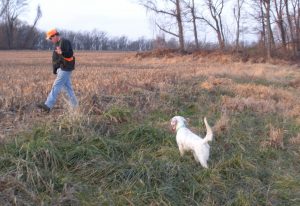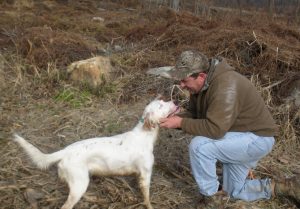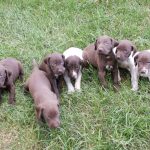Problem Solvers: Pressure on Pups
Pointing Dog Pointers
By Bob and Jody Iler
Years ago, a reputable dog trainer once told us, “More good pups are ruined by pushing them too fast and training them with too much pressure than anything else.” In our experience as professional trainers, we have often found this to be true.
We once attended a program where the demonstrator showed his method of force-breaking on a four-month-old pup. The little guy was fastened to a table post and subjected to having a bird crammed into his mouth as the attendees watched. Needless to say, the pup was not learning to hold a bird; rather, he was learning to dislike holding a bird—and the experience would undoubtedly put him off of birds in future training sessions.Force-breaking puppies to retrieve, steadying them to wing and shot, using the e-collar, improper bird introduction including poor use of releasers, and an overly accelerated gun development program all tend to intimidate young dogs and inhibit their natural abilities.
One client of ours brought his six-month-old pup to our kennel, wondering why the pup remained by his side when turned loose in the field. The pup showed no interest in hunting and was not demonstrating the unrestrained excitement most pups that age usually exhibit. On closer questioning, we learned the pup had been put through an e-collar obedience training program. This had put pressure on him to behave at all times and dampened his puppy enthusiasm for birds and fun.
Another customer of ours, an older and experienced dog man, brought a nice year-and-a-half old shorthair female to us, explaining that her problem was a lack of interest in hunting, and that often she would even deliberately ignore birds he knew were in the field. On our first session out with her, she blinked the bird and stood absolutely still when we flushed it. As we discussed her problems with her owner, he revealed that he had tried to steady her to wing and shot the prior year, before she’d even been hunted. As a result, she was so intimidated by the training that she ignored the scent of birds and was lackluster at best in the field.
Then there was the little female shorthair that came in for training and was afraid of birds. We found out from her owner that he had started her “training” by running her with his older dog in order for her to “learn the ropes.” In the process, she got spurred by a rooster. A bad experience with birds for a young pup had led to the fear.
Now and again you may read about young dogs that excel early, trained by eager, ambitious persons who often know their jobs well. We recall one young shorthair, less than a year old, that did well in advanced hunt tests but later began to lie down on point from too much training pressure.
And finally, we have more stories than we can relate about the young dogs that have come in to our kennel and were gun-shy. Each explanation was different and yet, each was the same. All the dogs had been exposed to gunfire before they had learned to love the birds. They were not developed to various levels of gun noise slowly, starting with the least noise and working up to higher levels. And most important, the gun development did not take place in stages, while the dog had its mind focused on the bird, nor was the dog’s reaction to the gun carefully noted.
In the above instances, the owners had gone by their own agendas, not by what abilities their pups were capable of at a given age. There are, of course, exceptions: the occasional very tough or bold pup that can handle more pressure, the extremely birdy, sound pup that seems to do everything well at an earlier age than most. But why take the chance?
Force-breaking, or “the trained retrieve” as we call it, can be a long and involved process. It’s best left until the pup is about 18 months of age, is hunting with enthusiasm, and has developed drive and experience in the field. If done too soon and with too much pressure, pups may lose interest in birds and shut down completely.Your pup must learn to love and trust you and to want to please you. He must learn in puppy fashion to love the birds before any advanced field training is initiated. He needs to live out his puppy days having fun and experiencing no pressure while being developed on birds, starting with smaller ones like quail and pigeons. He needs to make the mistakes that all youngsters do. As he learns and matures, and is hunted a season or two, he will develop the experience needed for more advanced training. But above all, he needs to be a bird dog first and foremost, before he becomes a bird dog that is gun-broke, steady to wing and shot, or trained to retrieve.
The e-collar is an effective training tool used to reinforce lessons already taught and understood by the dog. It’s not an appropriate tool for pups and young dogs, especially in the hands of the inexperienced. Trying to instill obedience and firm handling with an e-collar before developing the pup to birds and field work is putting the cart before the horse and can cause damage that may take months to undo.
Improper or careless introduction to birds can also set your training program back. So can the use of noisy bird launchers when used on young pups with no prior introduction to birds. Pups need to develop knowledge of bird scent, confidence, and feelings of fun and pleasure in their initial experiences with birds. We want these pups to be pulling us to the field, eager to find and—in the early stages—chase birds with gusto.
Steadying a dog to wing and shot is a final step in the finished dog program, and it is a point of no return. In other words, once that dog is reliably steady to the flush of the bird and the shot as it goes down, the dog must always be kept that way. It can be very difficult for the average novice owner/trainer to do this, especially if he hunts with others. Soon the dog will revert back to old habits of chasing birds at the flush. Many hunters never advance their dogs to this level of training and are happy not doing so. But for those who plan to compete in field events with their dogs, it’s crucial to keep their finished pointing dogs steady to wing and shot at all times. It is one of the most stirring sights to see in the world of pointing dog competition, and represents a lot of time, patience, and hard work on the part of dog and trainer. It is not an exercise meant to be taught to pups that should be allowed to have their heads when they are young.
As we have often said before, in your quest to develop your young pointing dog pup to his full potential—first, do no harm. Relax, take your time, and let your pup be a pup. Patience and thoughtful progression in training now will pay off later!
Pointing Dog Pointers features monthly training tips by Bob and Jody Iler, who own Green Valley Kennels in Dubuque, Iowa. Bob and Jody have trained pointing dogs for over 35 years and have written many articles for The Pointing Dog Journal.





